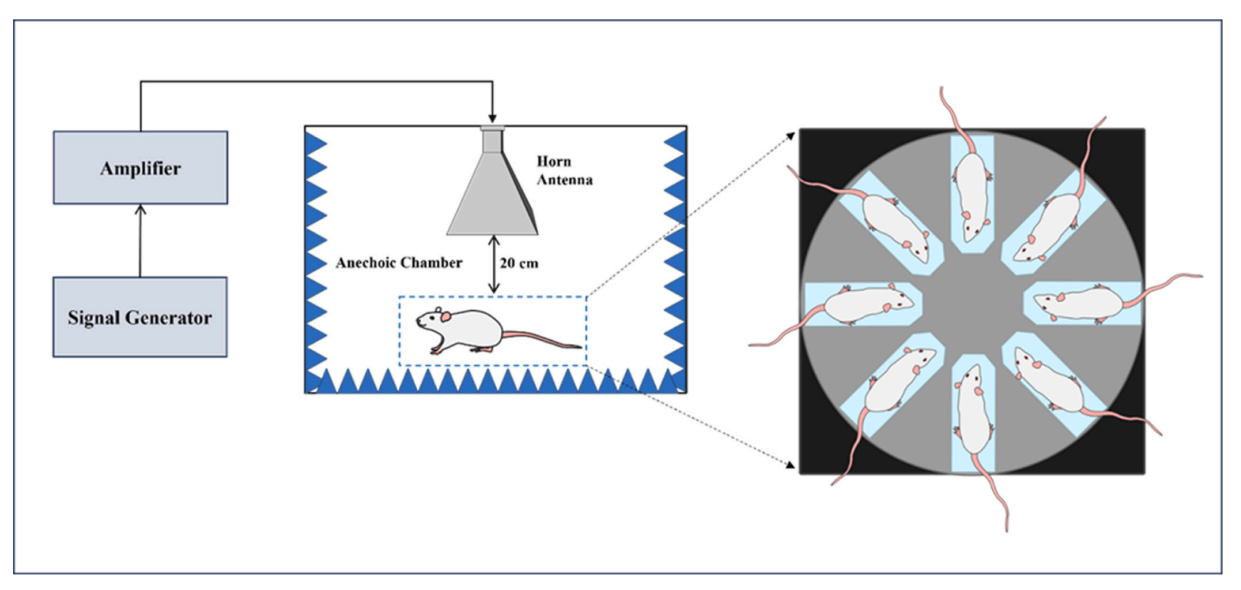Understanding the Study
Researchers in India "investigated the impact of 700 MHz [frequency electromagnetic radiation]... on the reproductive health of female Wistar rats." To do so, rats were split into three groups: (1) the control group which was not exposed to the radiation, (2) the sham-exposed group which entered the radiation exposure chamber but did not receive any dose, and (3) the exposed group that was subjected to the radiation. The exposed group was split further into two sub-groups. The short-term exposure group (n=6) received 6 hours of radiation daily for a period of 10 days. The long-term exposure group (n=8) received 4 hours of radiation daily for a period of 60 days. Various physiological parameters were monitored and "histopathological and biochemical analyses were conducted on harvested ovaries." The 700 MHz frequency radiation was chosen because it falls in the range utilized by 5G technologies; it has a wavelength of 42.9 cm. The animals were exposed to a power density of 0.7192 mW/cm2 with an average whole-body specific absorption rate of 0.375 W/kg.

The Case for Concern
The radiation exposed groups differed from the control group in several key areas. Long-term exposure (n=8) resulted in statistically significant changes in the weight of the liver and left ovary (though the small sample size diminishes the interpretation of this result). Additionally, statistically significant elevation in testosterone levels was observed with both short- and long-term exposure groups (though the levels were well within the healthy range for female Wistar rats).
Much more significant was the oxidative stress analysis which showed a significant increase in reactive oxygen species (ROS) generation for both exposure groups. The authors point out that oxidative stress and ROS generation are "natural processes that occur during physiological activities" but the lack of regulation of ROS production can "lead to oxidative damage in lipids, nucleic acids, and proteins within reproductive [and other] cells." This effect is well-documented and appears to be scientifically sound. However, the overall impact on human health is yet to be fully determined. All of these effects indicate the need for further long-term and cumulative exposure studies which may have "implications for fertility and reproductive health."
The Case for Confidence
In many of the most significant parameters assessed, there were no differences between the control and exposure groups. This includes no difference in (1) the length of estrous cycles, (2) estradiol and progesterone levels, and (3) key indicators of DNA damage.
Furthermore, the whole-body specific absorption rate (SAR) of 0.375 W/kg used in this study was quite high. The average whole-body SAR is somewhere around 0.01 W/kg (or less) for all frequencies of electromagnetic radiation combined. For example, the approximate whole-body SAR contribution due to Wi-Fi and Bluetooth is roughly less than 0.001 W/kg. The FCC regulates the whole-body SAR to roughly 0.08 W/kg, about 20% of the whole-body SAR used here. Thus, we have to question the actual danger posed by these levels of exposure in everyday life.
Final Analysis
The results of this study do raise alarm in a few key areas, but are mostly comforting to those in the Case for Confidence category, especially when it comes to the whole-body SAR applied to these Wistar rats. A drop of water is harmless. A few gallon of water could drown you. The question with electromagnetic radiation is simple: are we dealing with a drop of water or an ocean? That answer is yet to be fully determined, but we hope for the former.
References
N. Jha, P. Sarsaiya, A. K. Tomar, S. Pardhiya, J. P. Nirala, P. K. Chaturvedi, S. Gupta, and P. Rajamani, Reproductive Toxicology 135, 108910 (2025).

